The ASUS Maximus VIII Impact Z170 ROG Mini-ITX Motherboard Review
by Ian Cutress on December 29, 2015 9:00 AM ESTCPU Performance, Short Form
For our motherboard reviews, we use our short form testing method. These tests usually focus on if a motherboard is using MultiCore Turbo (the feature used to have maximum turbo on at all times, giving a frequency advantage), or if there are slight gains to be had from tweaking the firmware. We leave the BIOS settings at default and memory at JEDEC (DDR4-2133 C15) for these tests, making it very easy to see which motherboards have MCT enabled by default.
Video Conversion – Handbrake v0.9.9: link
Handbrake is a media conversion tool that was initially designed to help DVD ISOs and Video CDs into more common video formats. For HandBrake, we take two videos (a 2h20 640x266 DVD rip and a 10min double UHD 3840x4320 animation short) and convert them to x264 format in an MP4 container. Results are given in terms of the frames per second processed, and HandBrake uses as many threads as possible.

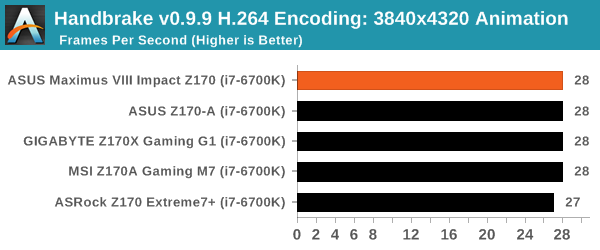
Compression – WinRAR 5.0.1: link
Our WinRAR test from 2013 is updated to the latest version of WinRAR at the start of 2014. We compress a set of 2867 files across 320 folders totaling 1.52 GB in size – 95% of these files are small typical website files, and the rest (90% of the size) are small 30 second 720p videos.
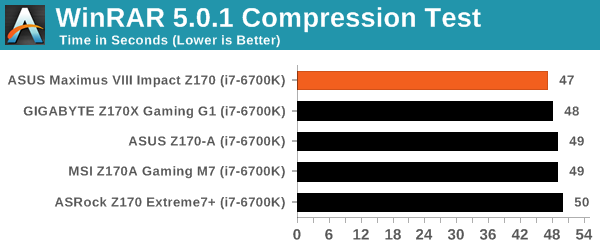
Point Calculations – 3D Movement Algorithm Test: link
3DPM is a self-penned benchmark, taking basic 3D movement algorithms used in Brownian Motion simulations and testing them for speed. High floating point performance, MHz and IPC wins in the single thread version, whereas the multithread version has to handle the threads and loves more cores. For a brief explanation of the platform agnostic coding behind this benchmark, see my forum post here.
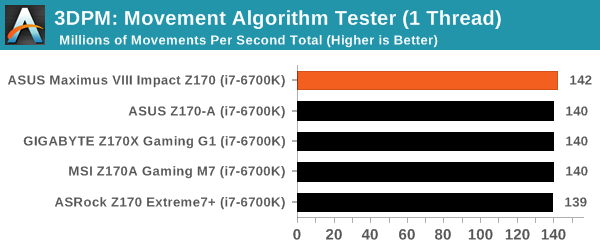
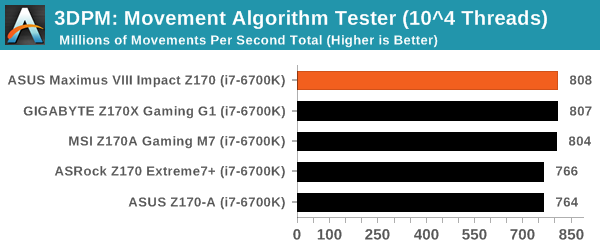
Rendering – POV-Ray 3.7: link
The Persistence of Vision Ray Tracer, or POV-Ray, is a freeware package for as the name suggests, ray tracing. It is a pure renderer, rather than modeling software, but the latest beta version contains a handy benchmark for stressing all processing threads on a platform. We have been using this test in motherboard reviews to test memory stability at various CPU speeds to good effect – if it passes the test, the IMC in the CPU is stable for a given CPU speed. As a CPU test, it runs for approximately 2-3 minutes on high end platforms.

Synthetic – 7-Zip 9.2: link
As an open source compression tool, 7-Zip is a popular tool for making sets of files easier to handle and transfer. The software offers up its own benchmark, to which we report the result.
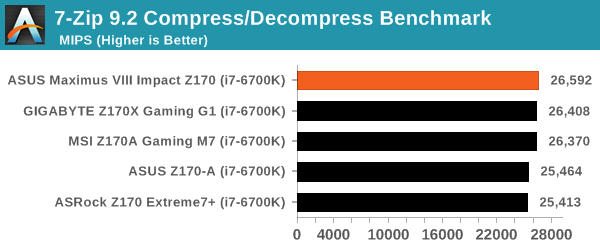










42 Comments
View All Comments
A5 - Tuesday, December 29, 2015 - link
I'd rather have 4 more USB ports than the wireless or debug LEDs, but this product isn't really for me to begin with.Flunk - Tuesday, December 29, 2015 - link
I agree with you, but 5 USB ports is pretty sufficient.Spyrano - Tuesday, December 29, 2015 - link
Agreed. I've actually got this board, and those USB ports get filled up fast. Would like a few extra, vs. the debug LED that I'm not sure I'll ever use.amnesia0287 - Thursday, July 7, 2016 - link
Ehhhh, being able to quickly diagnose a post failure is more useful to me than not needing a USB hub. Not many people have more than 1-2 high bandwidth devices connected, but even if they did, you also have the USB3.1 port at the top that you could run your 3.0 hub through with minimal impact. Also there is a usb3.0 header so there should be 2 more ports available to you, if your case doesn't have connectors you can always just just by a header to dual usb connector.LordanSS - Tuesday, December 29, 2015 - link
I know your feeling, still rocking my 3770k on a mATX board, and there aren't enough ports available for all my stuff (wheel, joysticks, extra programmable pads, etc).But to be honest, as Flunk stated, 5 ports is sufficient, as we're a minority. Got a powered USB hub with 7 ports a couple years ago, and all the "gaming" stuff connects there. Works great.
etamin - Tuesday, December 29, 2015 - link
I'd take a couple USB 2.0 ports over the sound card.UltraTech79 - Thursday, July 14, 2016 - link
Have fun gaming with no sound idiotgandergray - Tuesday, December 29, 2015 - link
Thank you for the quality review. As you note, competition (less expensive) seems to come from motherboards in the Asus portfolio, including: https://www.asus.com/Motherboards/Z170I-PRO-GAMING... .Vatharian - Tuesday, December 29, 2015 - link
Thank you for in-depth review! Sadly Asus is still repeating its old mistakes. First is 3-jack audio. Second, lacking in back USB department. Third, why they try to push DIMMs in premium (read: packed) form factor? SO-DIMMs would allow either dual channel or more space. M2 port is missing, nobody uses and will use U2. M.2 disk should be on the bottom side of board. Board lacks USB 2.0 ports (not everything works on 3.0, sadly). And while I'm personally baffled by people using wireless network on desktop computer, 2x2 is just a waste. For this price either include solid 3x3, or none at all. This board tries, tries, but lacks in every aspect it tries to conquer.vgray35@hotmail.com - Tuesday, December 29, 2015 - link
Does any mITX motherboard out there currently fit your requirements? I agree M.2 is a glaring ommission, but a world without wireless is a disaster even on a desktop PC, and especially on a mITX motherboard where I/O ports are constrained.